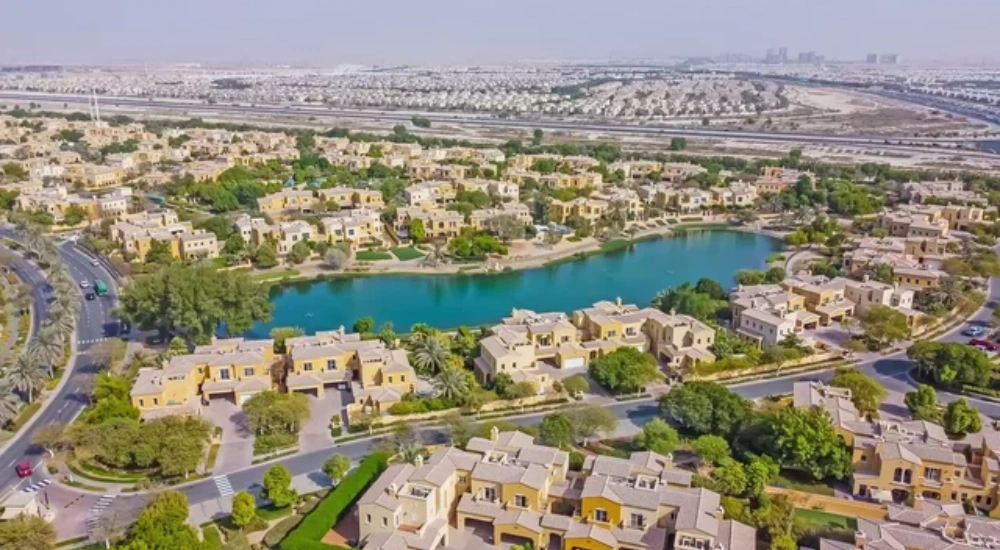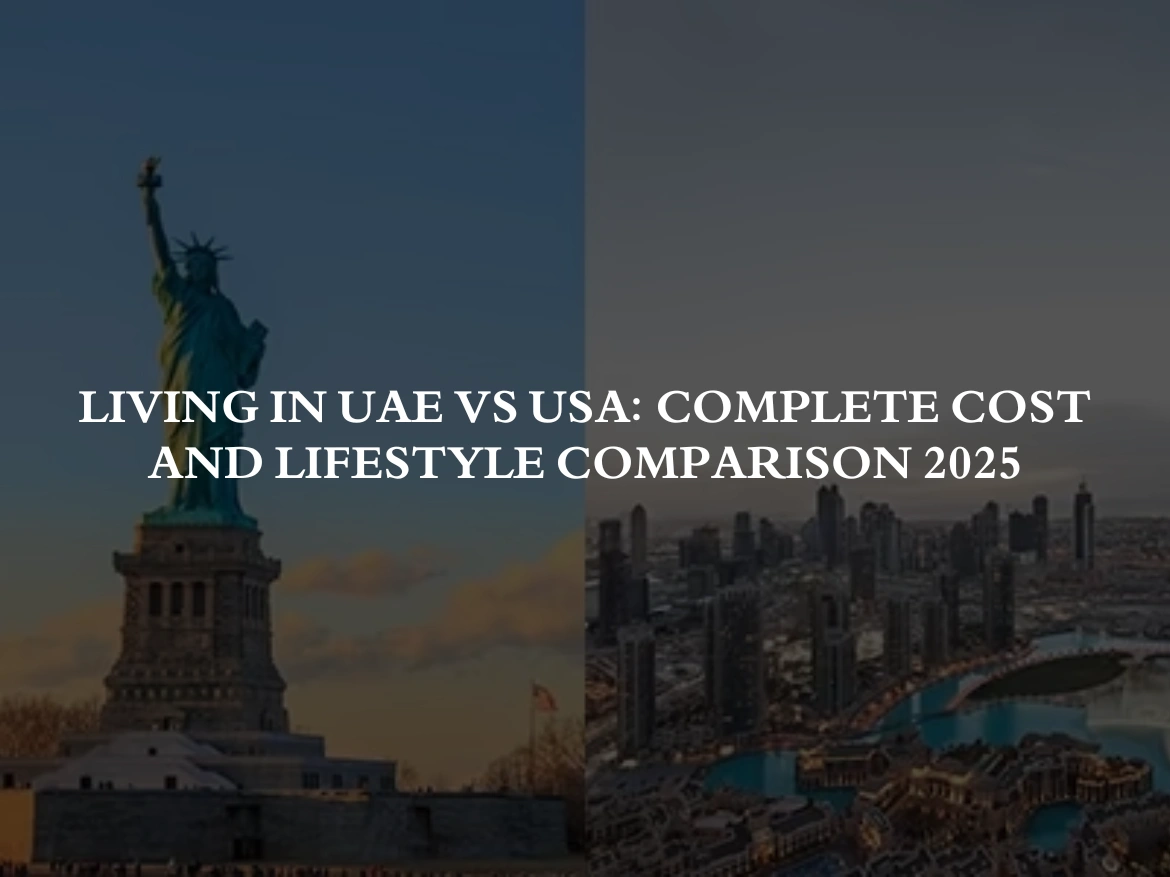Making the choice of whether to live in the UAE or the USA is a big one that will affect your job, your family’s health, and your finances. Professionals, families who want to find better opportunities abroad can gain in different ways from each country.
This comprehensive blog will help you compare these two places. The comparison uses data to give residents information that can help them make smart choices.
Understanding Living Standards: UAE vs USA
The cost of living index is one of the most important ways to compare how much things cost in different countries. The UAE has a score of 61.98, and the USA has an index of 71.92. This differential translates into significant savings for residents who prefer the Emirates over American cities.
Daily expenses in Dubai are approximately 50% lower than New York and 22% more affordable than in Miami. However, this advantage varies across different spending categories, with some areas favoring one country over the other
Housing Expenses

Accommodation represents the largest recurring expense for most residents. In central UAE locations, a one-bedroom apartment averages 6,123 AED monthly, compared to 6,362 AED in equivalent American city centers. The cost difference becomes more pronounced in suburban areas, where UAE properties rent for approximately 4,181 AED versus 5,252 AED in the US.
Larger accommodations present a contrasting picture. Three-bedroom apartments in UAE city centers command 12,595 AED monthly, while American counterparts average 10,562 AED. For families requiring spacious housing in prime urban areas, American cities offer better value. The UAE’s price for a three-bedroom apartment in the suburbs is 9,025 AED, and the US’s price is 8,771 AED.
Property purchase prices favor American buyers significantly. UAE city center real estate costs approximately 23,443 AED per square meter, double the US average of 11,912 AED. Even outside of prime areas, homes in the UAE still cost more than homes in the US, 13,493 AED vs. 10,022 AED.
Transportation

Transportation expenses reveal advantages for UAE residents in multiple categories. Public transit systems demonstrate clear cost differences, with a single journey ticket priced at 5 AED in the Emirates versus 9.18 AED in America. Regular commuters benefit from monthly passes costing 200 AED in the UAE, marginally cheaper than the 238.71 AED American equivalent.
In the UAE, taxi services can save you a lot of money. Initial charges start at 12 AED compared to 13.22 AED in the US. The biggest difference is the rate per kilometer. In the UAE, rides cost 2.50 AED per kilometer, while in the US, they cost 6.39 AED per kilometer. With these lower prices, taking a cab for short distances in the Emirates is a lot cheaper.
Fuel cost
The UAE also has cheaper fuel prices than the US. Gasoline costs about 2.82 AED per liter there, while it costs 3.30 AED in the US. This 17% difference lowers the cost of running a car for its owners. Prices to buy cars vary by type, and some cars are cheaper in one country than another.
A Volkswagen equivalent costs around 163,937 AED in the UAE but only 126,704 AED in the US. On the other hand, a Toyota sedan sells for 82,417 AED in the Emirates compared to 95,642 AED in America.
Utilities and Internet Services
Monthly utility expenses for an 85-square-meter apartment average 652.81 AED in the UAE, covering electricity, water, heating, cooling, and waste management. American residents pay slightly more at 771 AED for comparable services. Internet connectivity represents one area where the UAE costs significantly more. High-speed unlimited plans average 368 AED monthly in the Emirates versus 265 AED in the United States.
Mobile phone plans remain relatively similar in both nations. A standard monthly package costs 214.16 AED in the UAE and 221 AED in America, representing a minimal difference for communication expenses.
Need a More information About It?
Our agents will help you explore premium options tailored to your lifestyle, location preferences, and investment goals.
Grocery Shopping and Dining Expenses

In some areas, like food prices, the UAE always charges more than the US. About 90% of the food in the Emirates comes from outside the country. This means that grocery prices are higher because of the costs of shipping, customs clearance, and distribution.
Similar trends can be seen in restaurant dining, though restaurants in the UAE charge about 11% more than restaurants in the US. Middle Eastern and Asian places in the area offer cheap food for people who are watching their spending. Western-style restaurants, on the other hand, charge more. Even though it costs more, the UAE has a huge selection of high-quality goods and services.
Healthcare System and Medical Costs
UAE residents have a big financial edge when it comes to healthcare costs, which are on average 38% less than American prices. Everyone who lives or works in the UAE is required to have health insurance, and many companies offer basic coverage as part of the job. A lot of money has been put into modern hospitals and medical agreements with other countries, so everyone can use facilities that are among the best in the world. There are many options for coverage in the United States, both through government programs and plans offered by employers. However, the cost of coverage varies by region and job status.
Tax Implications
Taxes are probably the biggest difference in terms of money between living in the UAE and the USA. The Emirates has no personal income tax, which means that people who live there can get their whole salary without any fees. This benefit is especially useful for workers who make a lot of money and want to make even more.
The UAE does implement a 5% Value Added Tax on most goods and services, including groceries and dining. This does make daily costs go up, but not as much as the effects of the American tax system. The United States enforces federal income tax ranging from 10% to 37% based on earnings brackets. Additionally, state income taxes and sales taxes further reduce disposable income. For most expatriates, this taxation contrast serves as the primary financial motivator for relocating to the UAE.
Salary Levels and Disposable Income
In gross words, American salaries are usually higher than UAE pay packages. The average monthly net pay in the US is 15,867 AED, while in the Emirates it is only 11,329 AED. However, this gap becomes much smaller after deducting tax.
Residents of the UAE keep their whole salary, with no federal or state taxes taken out. This means they have more money to spend, even though their nominal wages are smaller. Professionals in the United States have big tax bills that cut their take-home pay by a lot. The difference in wealth between the two countries gets a lot smaller when you look at their real purchasing power.
Quality of Life Considerations
Both nations have the best infrastructure, safety, and lifestyle amenities. world class facilities, low crime rates, and high end leisure activities like desert adventures and indoor skiing make the UAE stand out. But summer temperatures above 40°C for three to four months make it hard to be outside. America has a wide range of weather, cheap fun things to do, and a culture that people are familiar with. In the UAE, you have to get used to following certain rules about how to behave in public. Most expats find this doable as long as they are aware and respectful.
Making Your Decision
The general cost of living in the United States is higher than in the UAE, especially when it comes to housing outside prime areas, transportation, and healthcare. However, groceries and internet services tend to be pricier in the UAE due to its heavy reliance on imports and infrastructure. Overall, the cost of living in Dubai is about 50% lower than in New York, giving residents a significant financial advantage. With tax free income in the UAE, professionals retain more of their earnings, which offsets the higher prices of certain goods and services. While salaries are higher in the US, the absence of income tax in the UAE ultimately helps balance overall affordability.
Conclusion
There are a lot of things to consider when deciding whether to live in the UAE or the USA, not just the cost. Income that isn’t taxed, cheaper healthcare, and easy access to public transportation are all big financial benefits of living in the UAE. America is good because it has a lot of different climates and cultural settings that people are used to. It also has lower food costs. Excellent infrastructure, safety, and job prospects can be found in both countries.
Your choice should be based on your personal financial goals, family needs, job goals, and lifestyle preferences. The UAE’s financial system is especially good for professionals with high salaries who want to save as much money as possible. America suits those prioritizing cultural familiarity and specific regional advantages. By doing research and careful planning ensure a successful relocation to either destination, allowing you to make the most of opportunities in your chosen country.





Join The Discussion